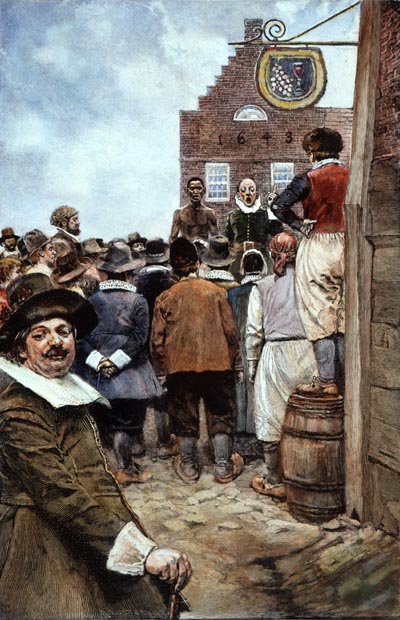First slave auction at New Amsterdam (1655)
First Slave Auction at New Amsterdam in 1655 by Howard Pyle, courtesy of Granger Collection, NY

As New Amsterdam grew in the 1600s, so did the demand for slaves. The West India Company was committed to building up the colony--but wanted to do so as cheaply as possible. First and foremost, the Company was motivated by economics. They realized that for the same cost as hiring a white laborer for just one year, the Company could buy an experienced slave from the West Indies. By the 1600s, slaves made up from 15 to 20 percent of the population of New Amsterdam.
Male slaves built public buildings, roads, and large walls (including the wall for which Wall Street is named). They also tended livestock, worked the farms, and helped unload cargo ships. Female slaves mostly did domestic work, such as cooking and cleaning. Slaves sometimes worked for attorneys and physicians. In pursuit of getting the cheapest labor force possible, the Company sometimes trained slaves in skilled labor such as carpentry and bricklaying.
During Dutch rule, living conditions for slaves in New Amsterdam were less brutal than for slaves in other North American colonies. For example, Slaves were given the same status as whites in court. In addition, slaves and masters often slept in the same house, ate the same food, and worked next to each other. Married slave couples were forced to live in separate houses and see each other only once a week, but sometimes secret meetings were arranged.
The West India Company occasionally granted veteran slaves a strange status called "half freedom." Slaves who were "half free" were permitted to own some property and have white servants, were allowed to travel freely, and had the freedom to marry (in the Dutch Reformed Church, of course). However, these slaves had to pay the Company every year--usually in the form of grain, furs, or wampum--and their children were considered "full slaves."
Despite pressures to conform to the Dutch way of life, many blacks continued to practice rituals from West Africa, such as elaborate funerals. They also adapted their African ways to new, American circumstances, inventing an annual festival called Pinkster, in which they mimicked Dutch authority figures and mocked them by electing their own king for a day.